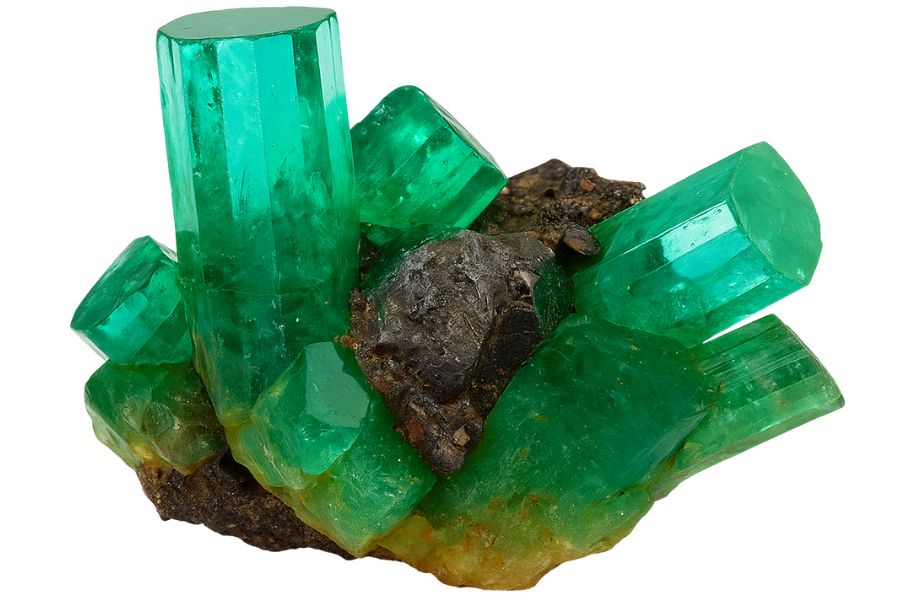Gem hunting in North Carolina is easier than most places in the country with its reputation for producing some of the finest gemstones around. Its diverse geology includes pockets rich with gem-quality material.
Creeks, riverbeds, and gravels often hold washed-down treasures waiting to be uncovered. Old mining areas have also produced spectacular stones, making them a prime choice for modern rockhounds.
Even natural erosion can reveal sparkling finds, hinting at the hidden wealth still scattered throughout the state.
What makes North Carolina especially intriguing is the sheer variety of gemstones that can be discovered. Some are common enough to fill a small collection quickly, while others are rare and highly prized.
We can help you learn what to search for and the types of places where these stones can be found. With this knowledge, you can walk away with an impressive mix of gemstones that few other states can match.
- The extensive local experience and understanding of our team
- Input from several gem hunting groups and organizations
- The accessibility of the mining locations
- Safety and potential hazards when collecting
- Private and public locations
- A desire to include locations for both experienced gem hunters and those who are just starting out
Overall, we’ve been able to put together a great list that anyone can use to locate a lot of beautiful gems.
The Gemstones Found In North Carolina You Can Mine
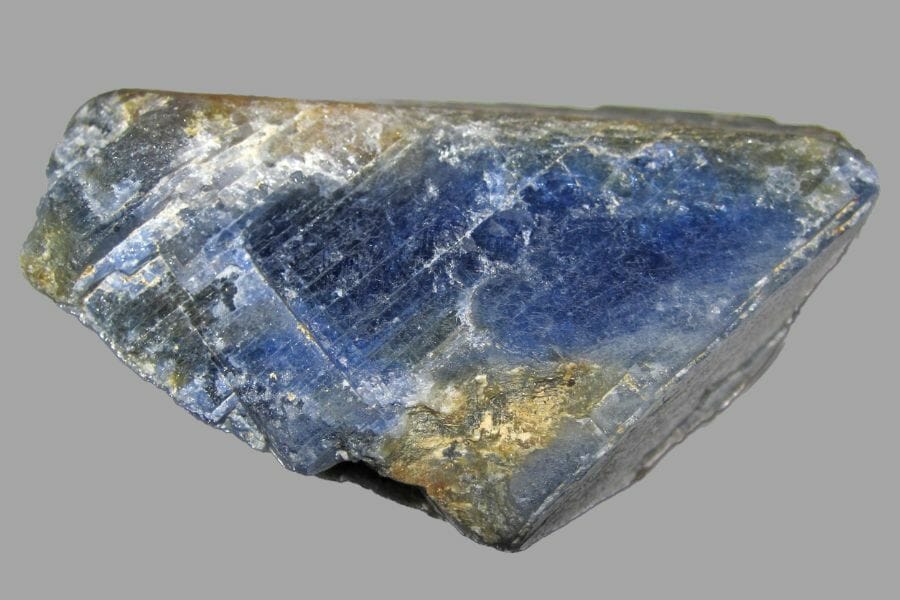
North Carolina is fortunate to possess some incredible gemstones! We created several guides to help you discover gem mines near you, since we understand that every state is blessed differently from one another and not everyone has access to this knowledge. By having the right information and a bit of luck, you can find both rare and more common gems here.
Emerald
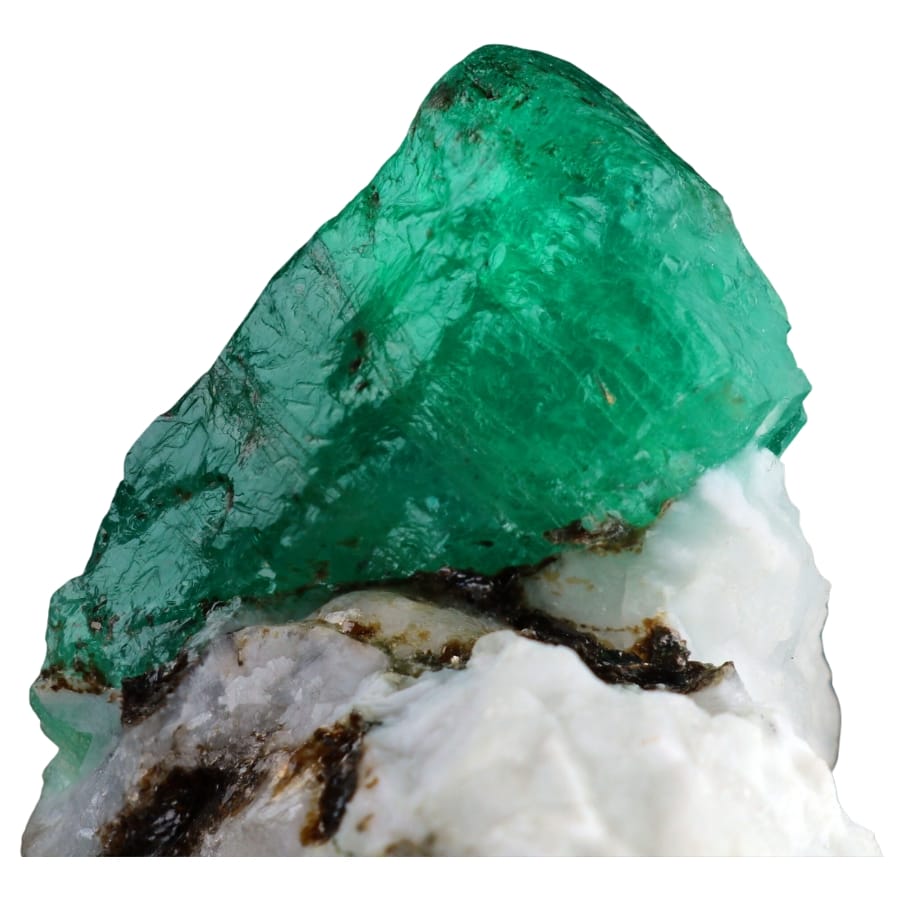
Emeralds are nature’s own green fireworks display. It’s one of the most popular gemstones in the world because of its bright, vivid green colors. Every time you look at one, it’s as if you’re peering into a lush, tropical rainforest.
It belongs to the beryl family of minerals, just like aquamarine. But what gives the gem its distinctive green color? It’s all thanks to small amounts of chromium and sometimes vanadium mixed in.
Let’s take a trip deep inside the Earth to discover how emeralds come to life. When hot magma from deep within the Earth rises and cools, it forms rocks.
As these rocks change over time, with heat and pressure, beryl minerals can form. If there’s chromium or vanadium around, bam! That beryl turns into the green wonder we call emerald.
Their dazzling green shades symbolize renewal and growth, just like spring. Throughout history, royalty has worn emeralds, signifying power and wealth. Today, whether it’s in a necklace, ring, or crown, emeralds have a timeless appeal that captures hearts and imaginations.
With their rich history, stunning beauty, and positive vibes, it’s no wonder emeralds shine so bright in the world of gems!
Where you can find Emerald in North Carolina
Emerald is abundant in these locations:
- Big Crabtree Mountain
- Crabtree Emerald Mine
- Emerald Hollow Mine
- Spruce Pine
- Thermal City Gold Mine
Hiddenite

Hiddenite! Now there’s a gem that dances with color and mystery. This lovely stone is a variety of mineral spodumene, and it has a stunning green color that can range from a pale, light shade to a richer, deeper green. Imagine the fresh green leaves of spring, and you’ll get a sense of Hiddenite’s beauty.
It forms in granite pegmatites, which are special rocks with interlocking crystals. It gets its beautiful green color when some things, like chromium, are around when spodumene is made. It’s how minerals are used by nature to make art.
Hiddenite is named after the mineralogist W.E. Hidden, who was the first to notice its unique properties. Its colors range from soft pastel green to bright shades that look like new leaves in spring.
Another exciting aspect is that it can show different colors when viewed from various angles, a feature known as pleochroism. All these wonders wrapped up in one gem make hiddenite a treasure for gem lovers and collectors everywhere!
Where you can find Hiddenite in North Carolina
Hiddenite can be found in many places, among them are:
- Farms in the Hiddenite area
- Many old area mines of Hiddenite
Aquamarine
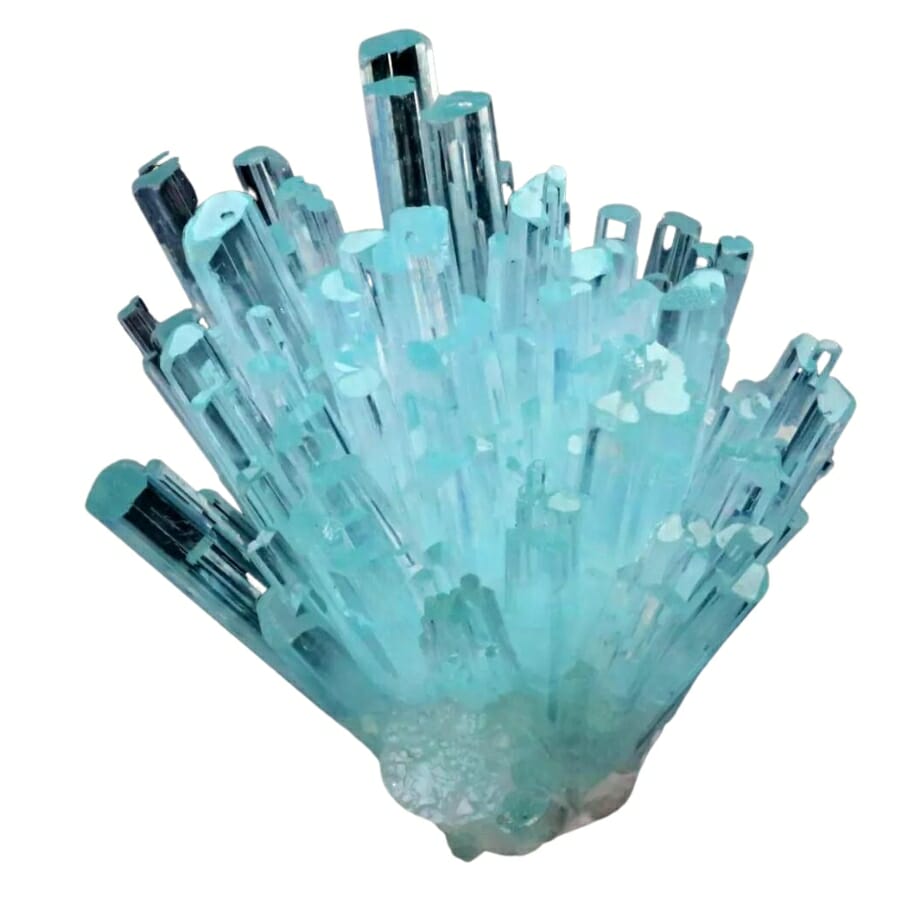
Aquamarine is a true treasure from the heart of the Earth! This gemstone is a dreamy blue to greenish-blue color that reminds you of clear, tropical oceans. The name “aquamarine” comes from two Latin words: “aqua” meaning water, and “marina” meaning sea. A pretty fitting name, right?
This stunning gem is part of the beryl family, which means it’s related to emeralds. These minerals form when molten rock deep in the Earth cools under certain conditions.
Aquamarine crystals grow with the right amount of beryllium, aluminum, and silicate. Over time, traces of iron sneak in, giving this gem its enchanting blue hue.
Its beautiful color and clarity make it a top choice for jewelry. Rings, necklaces, earrings – aquamarine shines in all of them! Its clear blue reminds many of calm seas and clear skies, making it a favorite for those who love ocean vibes.
In essence, aquamarine combines the mysteries of the Earth with the allure of the sea. Wearing or owning this gemstone feels like holding a tiny piece of the ocean’s heart!
Where you can find Aquamarine in North Carolina
You can visit these places to find aquamarine in the state:
- Crystal Ridge
- Escondido Canyon
- Shelter Cove
Azurite
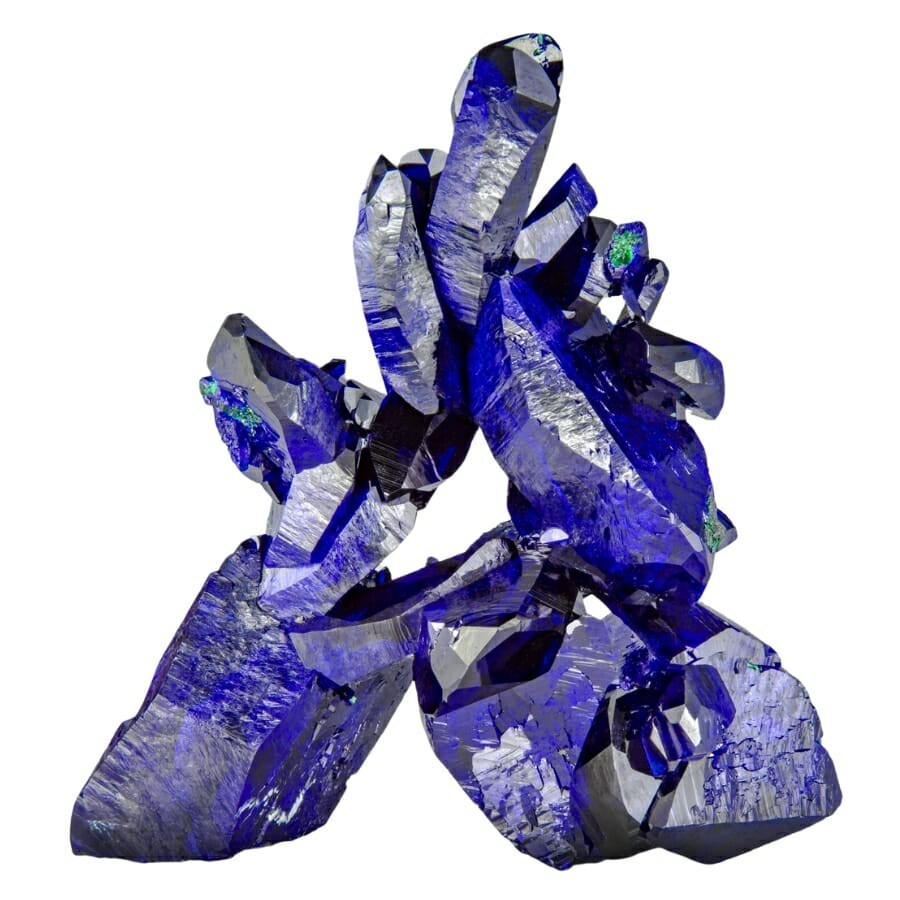
Azurite is a total dazzler! Its name comes from the Persian word “lazhward,” which means “blue.” Its deep, bright blue color makes it easy to see why. People used to grind this gem into a fine powder and mix it with paint to make it bright blue.
Here’s a fun fact! Azurite is basically blue copper. Well, not exactly, but it does happen when water, carbon dioxide, and copper mix. When these elements react, they create this beautiful blue mineral.
Beyond its stunning appearance, it has been treasured for centuries. Artists, as mentioned, loved the rich blue hue it gave to their paintings. It’s a favorite among gem and mineral collectors today.
When you look at it, you can see the history of our planet and the magic that happens when elements come together in the most beautiful ways. Whether in a piece of jewelry or a rock collection, azurite shines bright as a reminder of how amazing nature is.
Where you can find Azurite in North Carolina
Azurite can be found all over North Carolina, especially in the following places:
- Bennett area mines and prospects
- Elk Knob
- Old area mines of Eldorado
- Reed Gold Mine
Chrysoprase
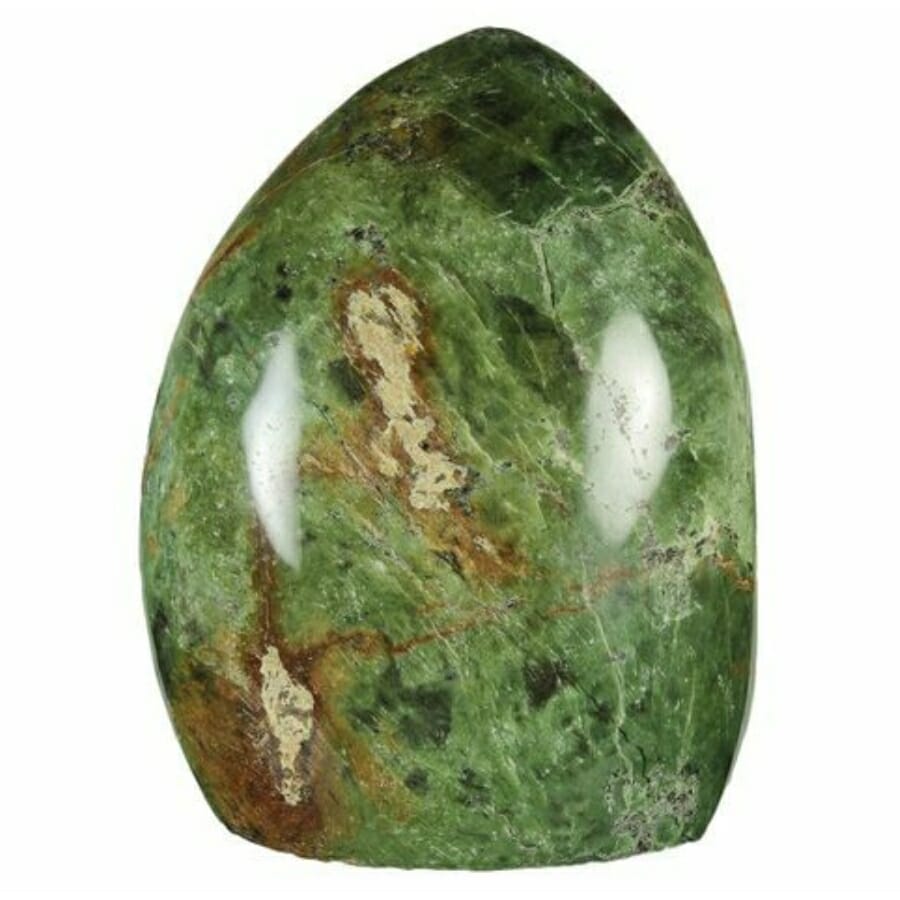
Chrysoprase is a real gem, literally and figuratively! Imagine the fresh green of young leaves or the vibrant color of green apples. That’s the captivating hue of chrysoprase, making it a standout in the gem world.
This stone belongs to the chalcedony family, and nickel gives it its unique green color. It comes from the tiny amounts of nickel mixed with the chalcedony.
People have been smitten with chrysoprase for a long time. Ancient civilizations used it in jewelry and decorations. Fast forward to today, and it’s still a hit!
Jewelers love it because that lush green makes a piece look elegant and lively. It’s often made into beads, cabochons, or very detailed carvings.
In essence, chrysoprase is a delightful combination of Earth’s artistry and ancient stories. Whether we wear it as a necklace or a treasured stone, it brings a touch of nature and history into our lives.
Where you can find Chrysoprase in North Carolina
Chrysoprase can be found in places such as:
- Lookout Mountain
- Pisgah Mountain
- Sugar Mountain
- Walker’s Knob
Cuprite
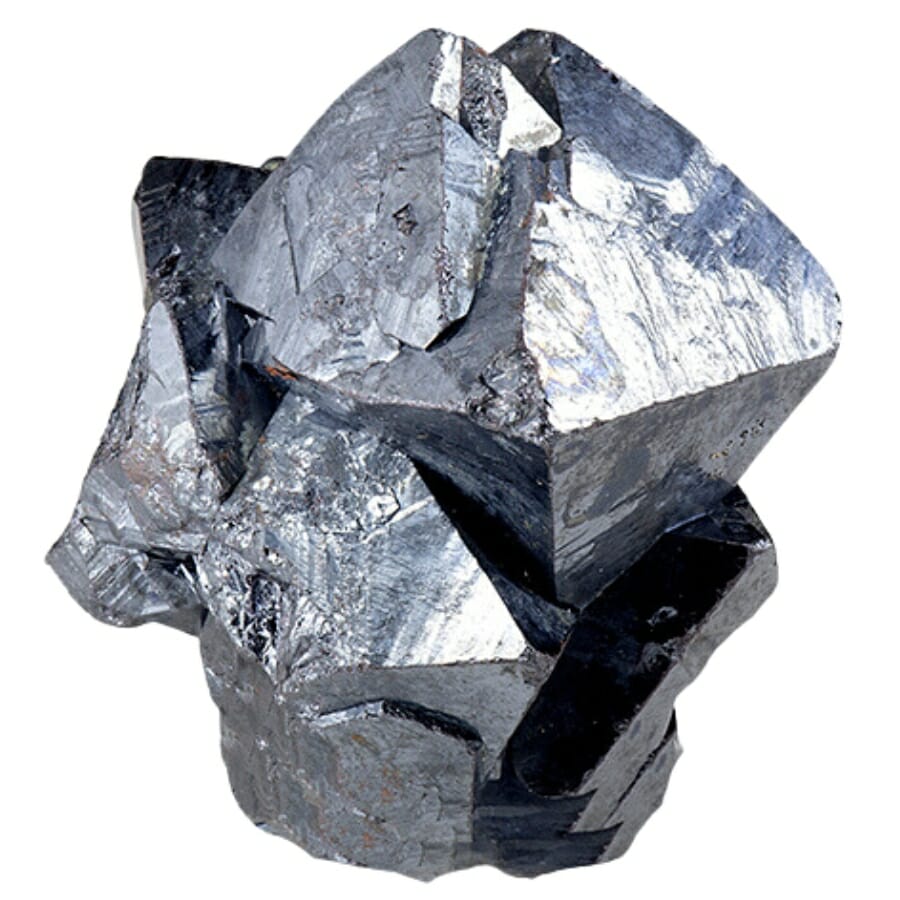
Picture a gem that shines with a deep red hue, almost like it’s holding a tiny fire inside. That’s cuprite, and it’s a sight to behold.
Here’s a remarkable fact: cuprite has much to do with copper. It forms when copper reacts with oxygen. So, in a way, you could say cuprite is what happens when copper takes a deep breath!
Its intense color is a showstopper. This makes it a prized find for mineral collectors. They always look for a perfect, shiny piece of this mineral to show off in their collections.
Then there’s the practical side of things. It has a high copper content. This means it can be a valuable source of copper metal. So, people mine it, not just because it looks pretty, but because it’s practical too!
Cuprite is a reminder of how amazing things can happen when the right parts of nature come together. It never fails to impress, whether you’re looking at its fiery glow or taking the copper out of it.
Where you can find Cuprite in North Carolina
Cuprite is abundant in North Carolina, especially in the places listed below:
- Many area mines in Davidson County
- Mine dumps near Elk Creek in Stratford
- Reed Gold Mine
Opal
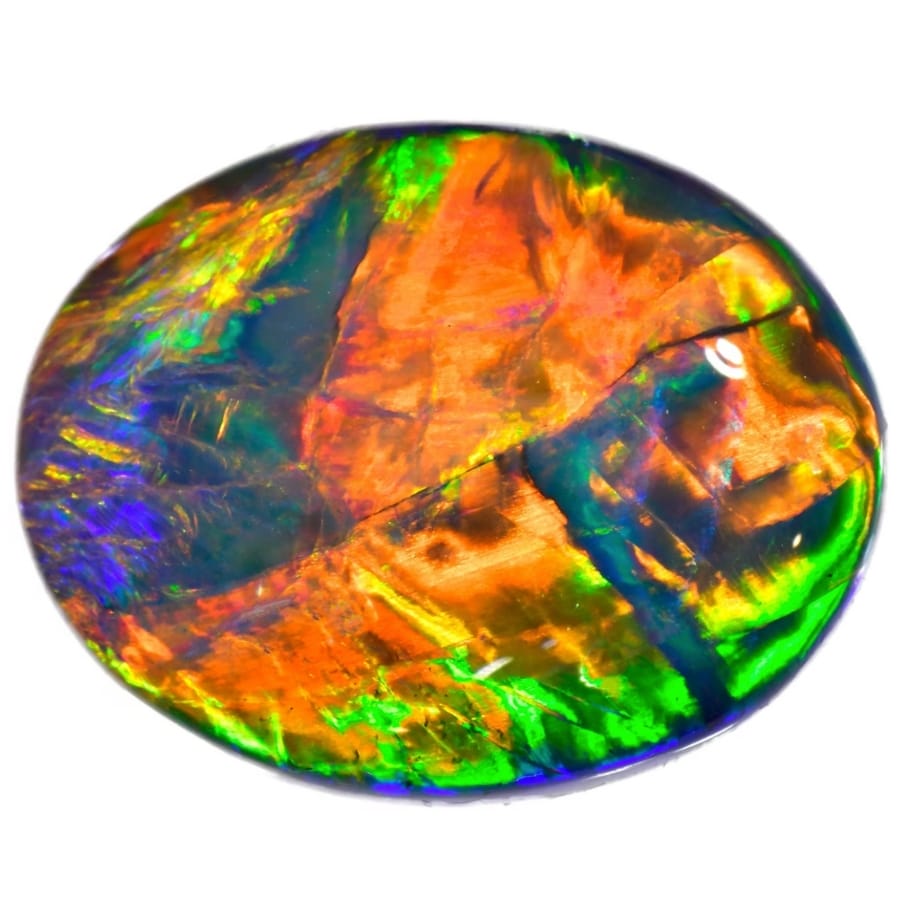
Opal unveils a world of iridescence and wonder that captures the eye and imagination. Composed of silica and water, opal’s formation is a delicate dance of geology and light.
It comes out of holes in old rocks, where water and silica mix in a way that uniquely combines chemistry and art. As water seeps into cracks and space in rock formations, it takes the dissolved silica and forms into opal.
Opal’s iridescence is caused by how the silica spheres are arranged in this lattice. When light passes through these, it bends and scatters, making a beautiful play of colors like rainbows and galaxies.
It shows that Earth can make art by making a gemstone that magically catches and reflects light.
The way opal looks makes it valuable. It connects us to the hidden beauty of the Earth and shows us how many colors there are in the universe.
Where you can find Opal in North Carolina
Opal can be found in a lot of places in North Carolina, especially in the following places:
- Cape Fear River
- Deer Park Mine
- Elijah Mountain Gem Mine
- Higdon Mountain
- Stream gravels and fields to Harrisburg
Ruby
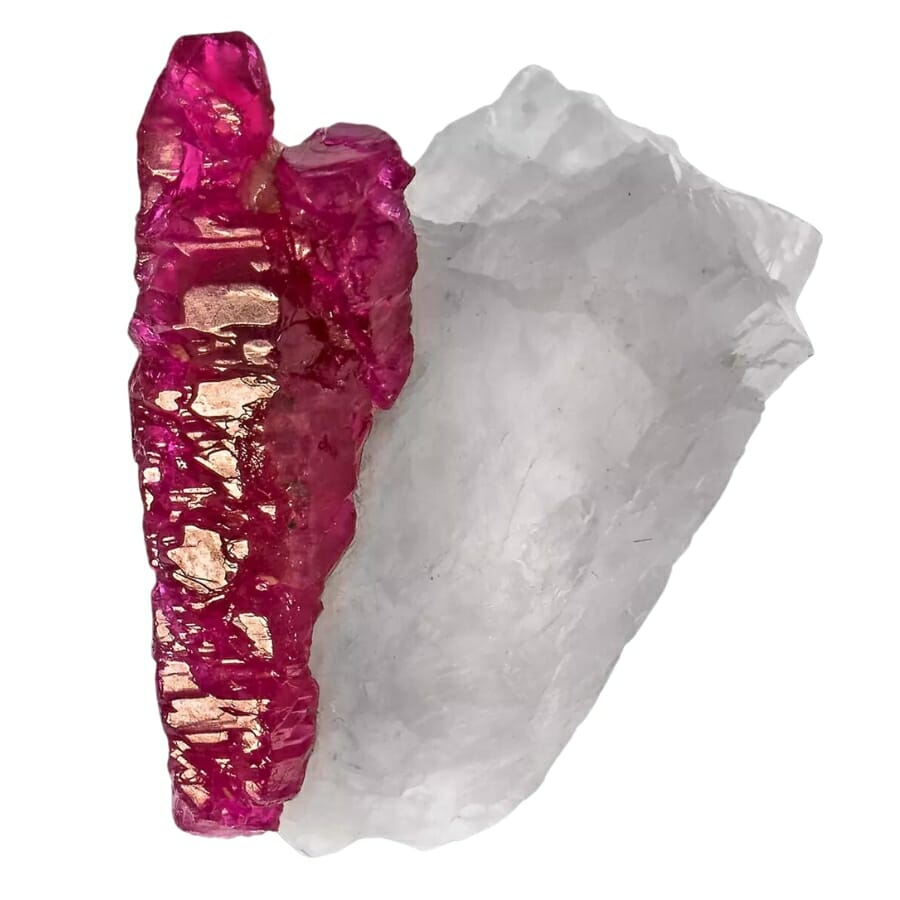
Ruby is a true gem, and not just because it’s considered one of the precious stones! This beauty shines with vibrant red, ranging from pinkish tones to deep, blood red.
The name “ruby” comes from the Latin word “ruber”, which means red. So, when you think of a ruby, think of fiery passion and intense color!
Here’s the magic behind its formation: rubies comprise a mineral called corundum. On its own, corundum is pretty much colorless. But when tiny amounts of chromium get mixed in, the magic happens! The chromium gives the mineral its iconic red glow.
Its gorgeous red color makes it a favorite for jewelry. Think of all the stunning ruby rings, necklaces, and earrings you’ve seen.
Because of its hardness, second only to diamond, it’s perfect for everyday wear. It also has a rich history. Kings and queens have worn them both in the past and present.
It represents deep love, history, and some of nature’s magic. Ruby is still a valuable and timeless symbol of beauty and strength that continues to inspire and captivate.
Where you can find Ruby in North Carolina
Ruby is abundant in North Carolina, mainly in the following areas:
- Corundum Hill
- Gem Mountain Gemstone Mine
- Rose Creek Mine
- Sheffield Gem Mine
- Thermal City Gold Mine
Scheelite
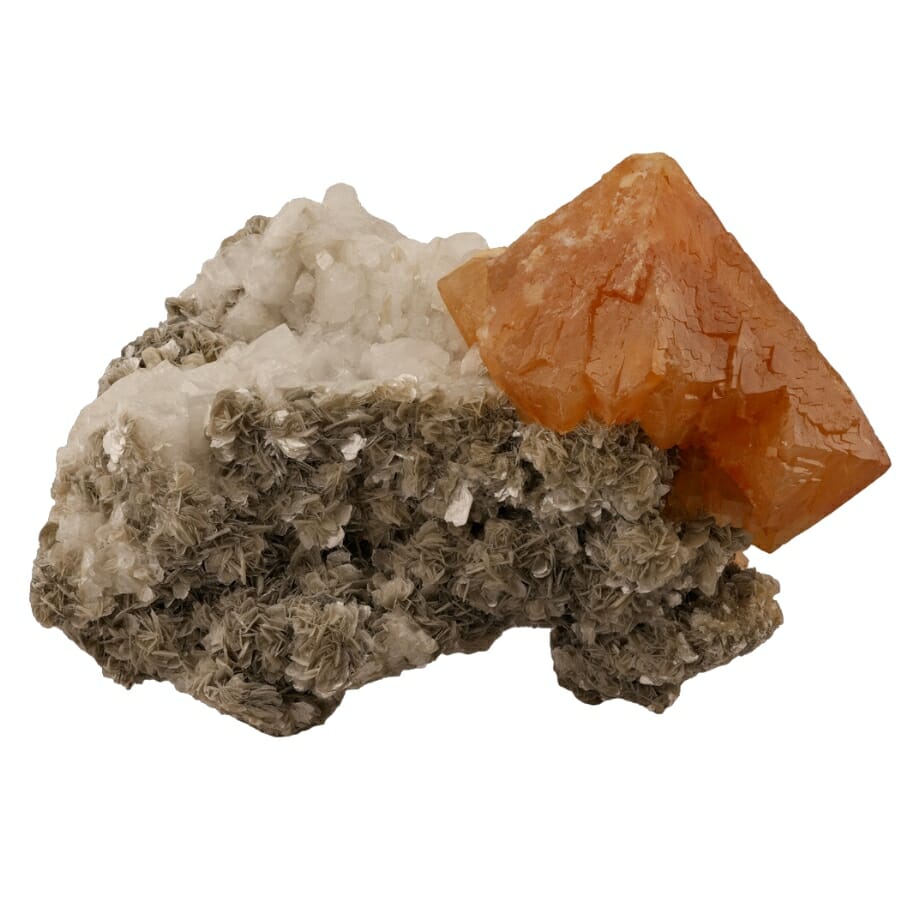
Scheelite is an absolute wonder in the mineral world! First, when you spot this gemstone, you’ll often see vibrant colors. It can shimmer in whites, yellows, oranges, and even browns.
This gem is extra special. It can glow bright blue or white under ultraviolet light, a beautiful sight.
Scheelite forms in high-temperature veins of rocks and sometimes in granite pegmatites. This means it often forms in hot fluids underground, which harden as they cool. It’s mostly made up of calcium and tungsten combined with oxygen.
Beyond its glowing beauty, it’s a significant source of tungsten. Tungsten is a solid metal used in many things, like the filaments of light bulbs and tools that need to last a long time.
In short, scheelite is a feast for the eyes and an industry workhorse. It’s a perfect example of how nature blends beauty with usefulness. The next time you see something made of tungsten, remember the incredible scheelite that made it possible!
Where you can find Scheelite in North Carolina
You can find a lot of scheelite in North Carolina, particularly in these places:
- Area mines to Little Island Creek
- Reed Gold Mine
Amazonite
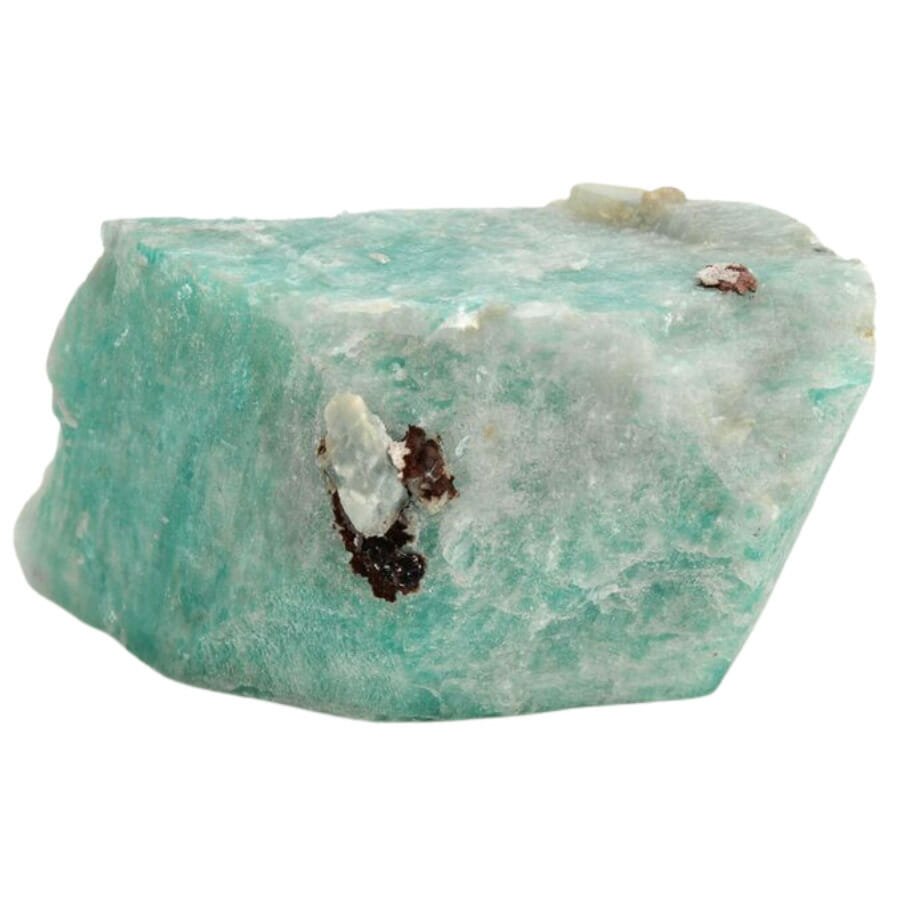
Amazonite is a real showstopper with its stunning turquoise-green color! Its calming shade is a reminder of tropical waters or serene forests. It’s named after the Amazon River, even though there’s no proof it was found there. Just think of a vast river and lush rainforest when you imagine its color.
It belongs to the feldspar family, a group of minerals that can be found in many rocks around the world. Amazonite forms in granite and pegmatites. It also gets its color when certain conditions happen deep within the Earth.
Beyond its eye-catching color, it has been used for thousands of years. Ancient civilizations crafted it into jewelry, beads, and other ornamental items. Many jewelry designers still love using it for its natural beauty and soothing color.
Amazonite’s peaceful colors remind us of the beauty of nature on Earth. At the same time, the fact that it’s still valuable and popular shows that it will never go out of style.
Where you can find Amazonite in North Carolina
Amazonite is easy to find in North Carolina, specifically in these locations:
- Elijah Mountain Gem Mine
- Ray Mica Mine
- Spruce Pine
Barite
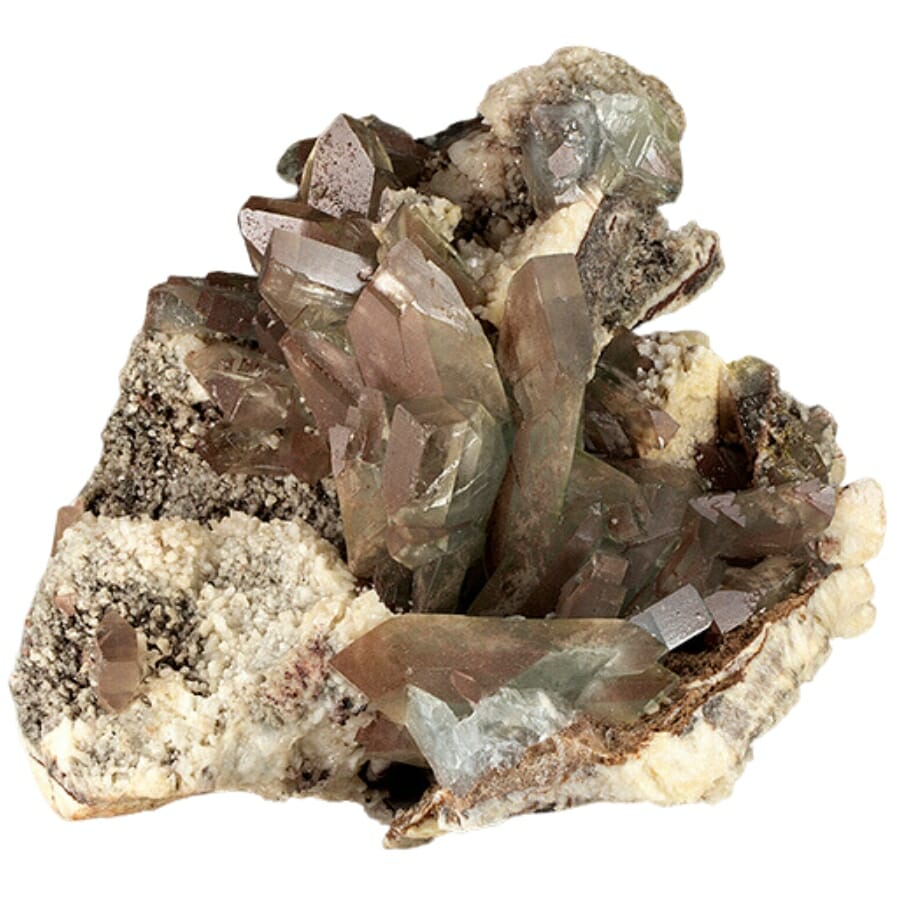
Barite sure knows how to make an entrance with its heavy weight! This mineral is much heavier than you’d expect for its size. It comes in various colors such as clear, white, blue, yellow, or brown. Sometimes, when you look at it closely, it has a cool glassy shine.
This mineral can form in various places, such as hot springs, the sea, and even in veins inside rocks. When the substances that make barite get into deep-ground solutions, it forms crystals.
Because it’s so dense and heavy, it’s used in things that need added weight. Think of those mud mixtures used in drilling oil wells. It helps keep the drill bit steady by making the mud heavy. Its high density is also a contrast agent in X-rays and CT scans.
In the grand tapestry of minerals, barite is both practical and pretty. It’s a cool combination of nature’s artistry and usefulness.
Where you can find Barite in North Carolina
Barite can be found in these areas in North Carolina:
- Crowder’s Mountain State Park
- Reed Gold Mine
Cerussite
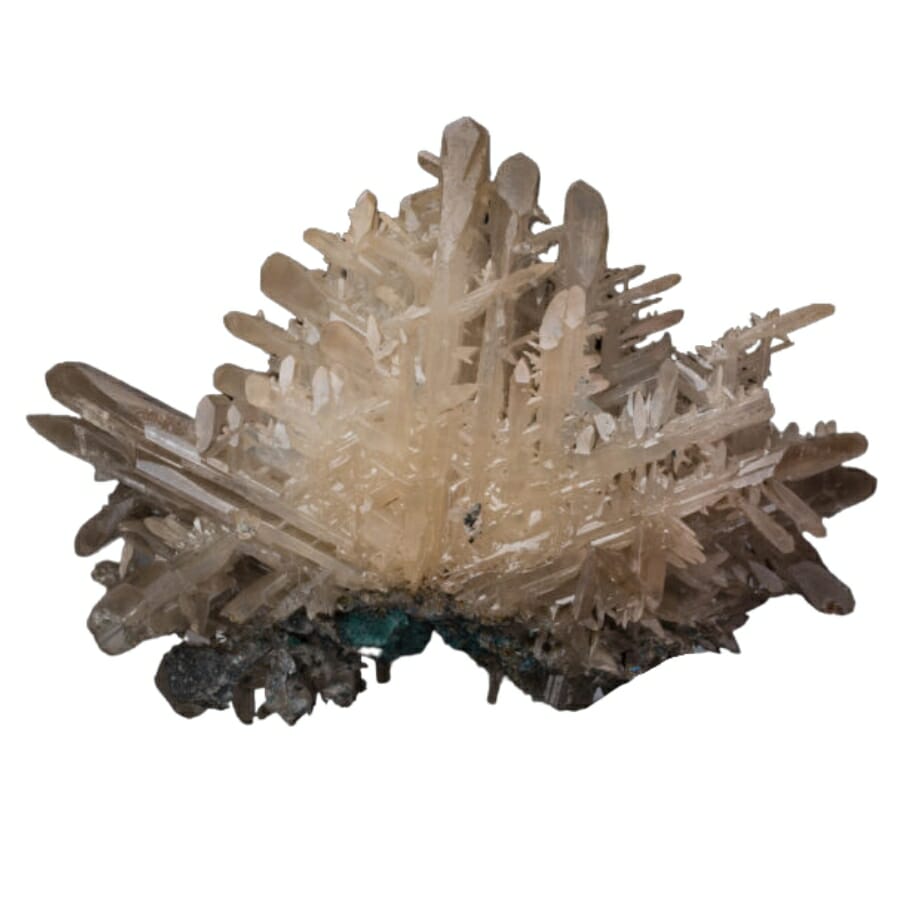
Cerussite is a mineral that stands out because it has sparkly crystals that can look as clear as glass or shimmer with a hint of color. This mineral often takes on fantastic shapes that catch the eye of anyone who sees them. You might even see twin crystals, made of two crystals that grow together uniquely!
It’s commonly found in areas where lead ores, like galena, are breaking down. This usually happens near the Earth’s surface, in the oxidized zone of lead ore deposits.
Lead ores change over time with the help of water and air to become minerals like cerussite. It’s how nature reuses old rocks and gives them a new, sparkly life.
For many, it’s all about its beauty and brilliance. When light hits a clear cerussite crystal just right, it dances with bright sparkles. This makes it a favorite for mineral collectors.
Plus, it has a special ability: it’s very flexible with light, which means it breaks light into several rays, making it even more stunning.
Cerussite is a testament to how the Earth can transform something ordinary into a true work of art. It’s a gem of a reminder about the magic tucked away beneath our feet!
Where you can find Cerussite in North Carolina
You can find unique pieces of cerussite in North Carolina, especially on the western slope of Davis Mountain.
Kyanite
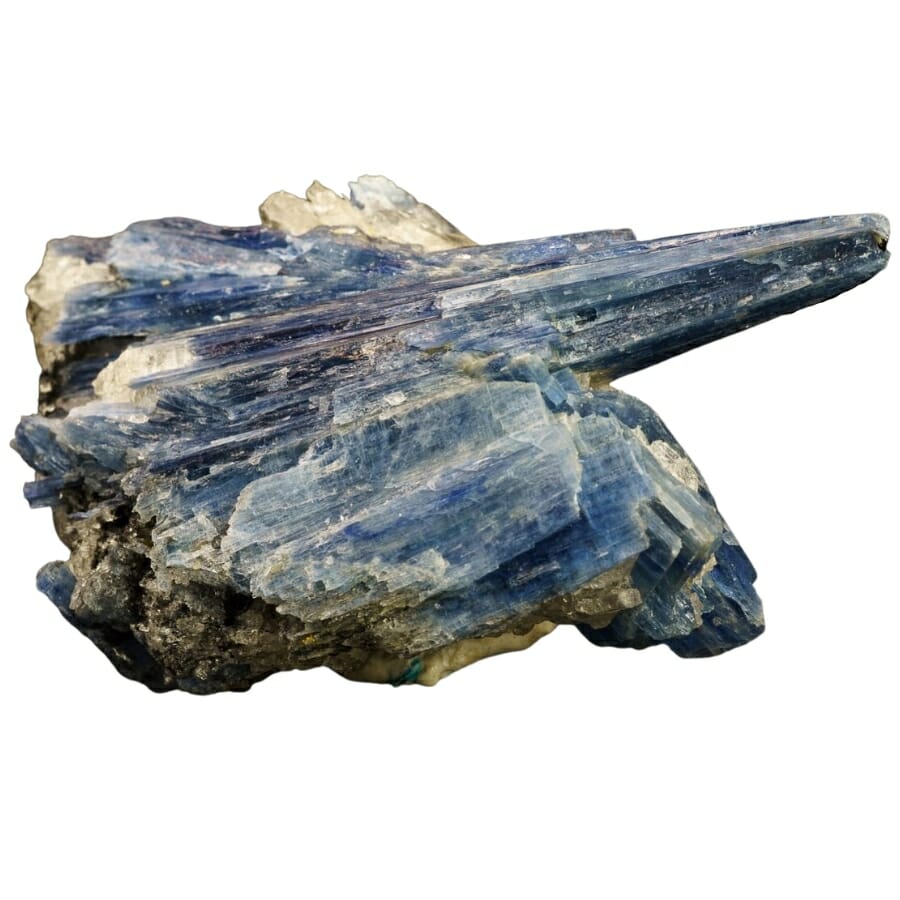
Kyanite is a fascinating stone, primarily because its unique blue color reminds many of a clear blue sky on a sunny day. This mineral can be light blue to dark blue, and its crystals often have white lines.
It’s made when there is a lot of pressure and heat, usually deep in the Earth’s crust. Its shape is unique because it can stand up to different conditions. In simple terms, the heat and pressure inside the Earth cook up this mineral, making it out of other materials.
It’s often used in rings and pendants, but it’s also used in other jewelry. It also has some valuable properties that make it useful in some industries. It can be used in things that handle high temperatures, like ceramics.
From the center of the Earth to jewelry, kyanite is a remarkable mineral that shows how beautiful and useful nature is.
Due to its anisotropy, it’s often used as a refractory material in high-temperature environments such as furnaces and kilns.
From the center of the Earth to jewelry, kyanite is a remarkable mineral that shows how beautiful and useful nature is.
Where you can find Kyanite in North Carolina
You can locate kyanite in the following areas:
- Cherokee Ruby and Sapphire Mine
- Cowee Creek
- Crowder’s Mountain State Park
- Lookout Mountain
- Ray Mica Mine
Lepidolite
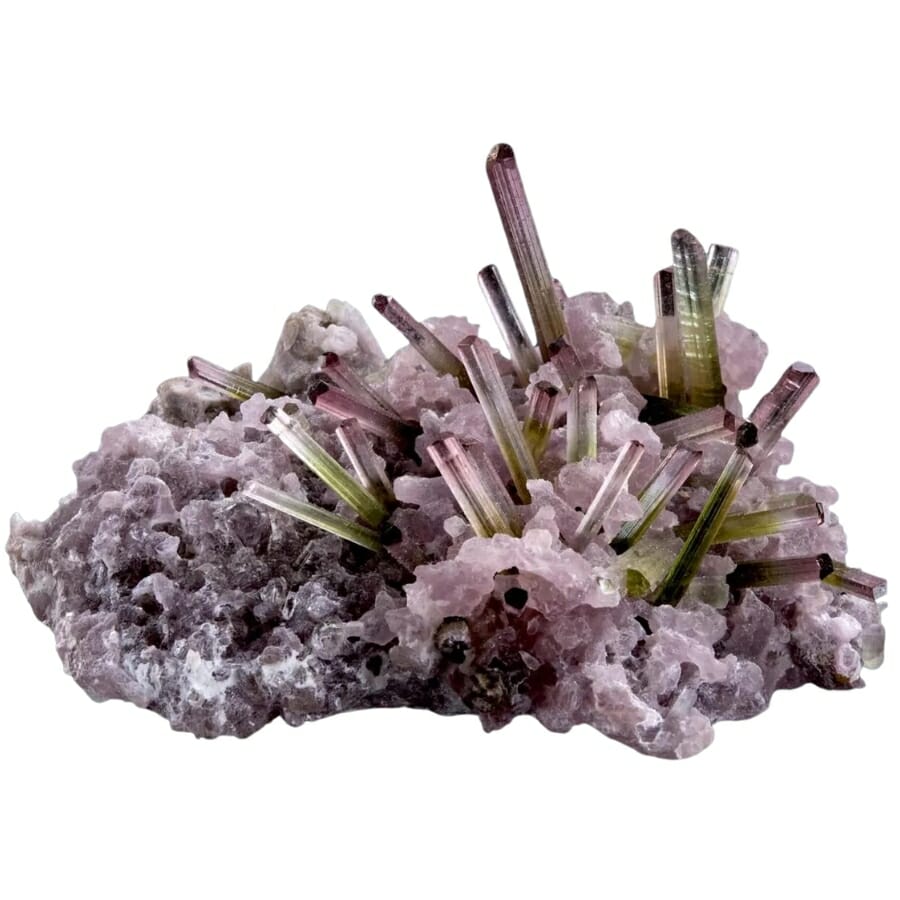
Lepidolite is a beautiful mineral that often stands out because of its beautiful purple, pink, and red colors. This mineral looks shiny and flaky because it has tiny bits of mica in it. It’s easy to think of it as “nature’s glitter” sometimes.
It forms from the cooling of magma or sedimentary rocks. The magic starts deep within the Earth. As magma cools and solidifies, various minerals start to grow.
It likes to form with other minerals like quartz, feldspar, and tourmaline. Over time, these minerals work their way to the surface of the Earth, where we find them.
Lepidolite contains a tiny bit of lithium. That’s the same stuff used in rechargeable batteries for our gadgets. But don’t rush to break apart your lepidolite stone to charge your phone; we have other ways to get lithium!
And, of course, its beautiful colors make it a top choice for jewelry and decoration. Imagine having a piece of Earth’s glitter to wear or display!
Where you can find Lepidolite in North Carolina
It’s not hard to find lepidolite in North Carolina, especially in these locations:
- Area near the county border of Inez
- Fowler Farm
Spodumene
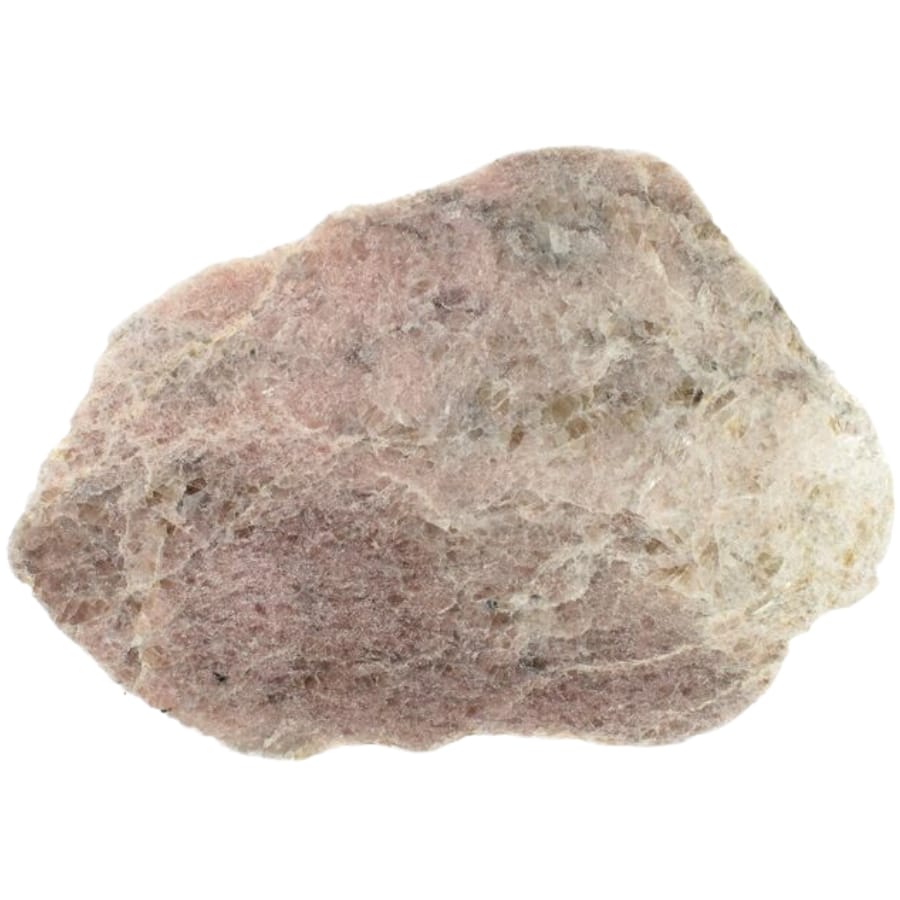
Spodumene is a real show-stopper in the world of minerals! With vibrant shades ranging from clear and colorless to deep green and pink, this gem is a feast for the eyes.
The green spodumene is called hiddenite, and the pink one is called kunzite. Each color is beautiful and charming in its way.
Spodumene forms from cooling magma deep within the Earth. As magma cools and hardens, various minerals begin to grow, and spodumene is one of these minerals. It often grows with other beautiful crystals, such as quartz and tourmaline.
It also contains lithium. Yes, the same element used in batteries powers many of our devices. This makes it incredibly valuable for technological advances and energy solutions.
Spodumene is also beloved in the world of jewelry. The vibrant kunzite and hiddenite varieties are often shaped, polished, and set into stunning pieces that catch the light brilliantly.
Many people love spodumene crystals, either because they are functional or beautiful. They are an excellent example of how the Earth makes terrific things for us to enjoy and use.
Where you can find Spodumene in North Carolina
You can visit the following places for unique pieces of spodumene:
- Foote Mine and other mines near Kings Mountain
- The general area of Stony Point
- Poplar Springs
Chrysocolla
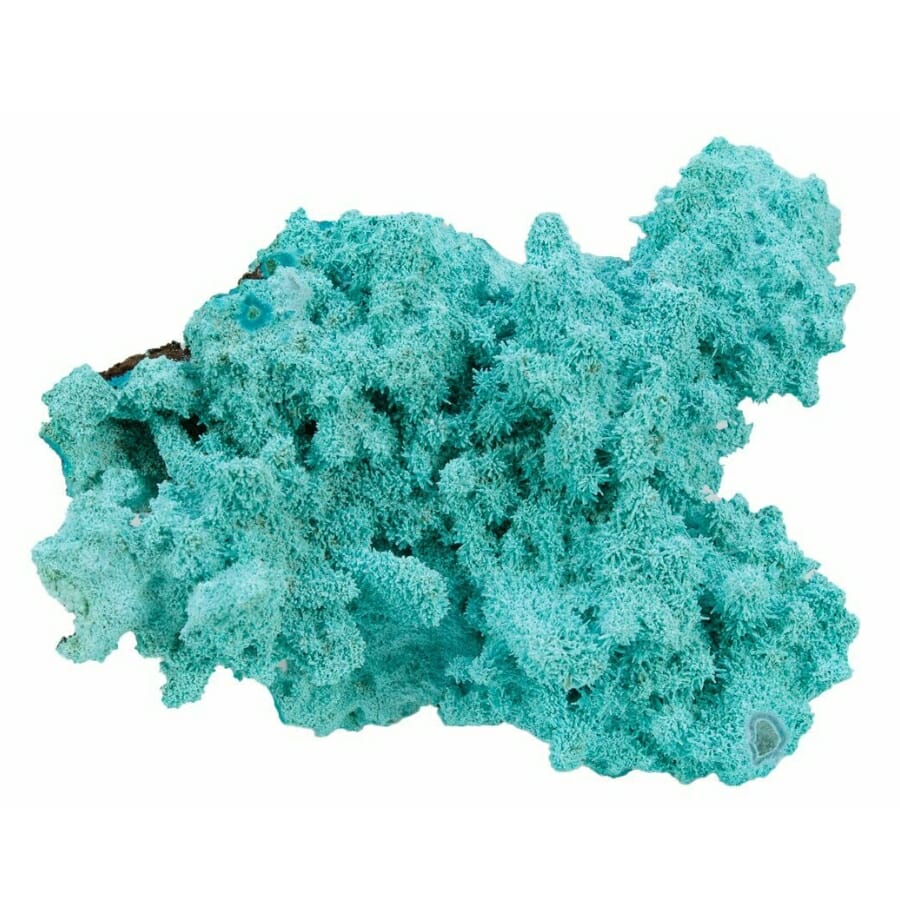
Chrysocolla is a real treasure in the world of rocks and minerals. It stands out because of its bright blue-green color, which makes people think of tropical seas and lush forests.
This stunning mineral is born when copper ores meet water. Imagine water dancing over and flowing through rocks rich in copper. As they come into contact, the water breaks down the copper, making the beautiful chrysocolla.
Ancient people liked its beauty and used it to make jewelry and art. Recently, it has become a popular material for lapidaries and jewelry makers.
Because of its bright colors and decorative patterns, it’s often used to make one-of-a-kind jewelry, from tiny pendants to big rings.
Chrysocolla is a beautiful stone that shows how nature’s chemistry works and tells stories from places as cool as North Carolina.
Where you can find Chrysocolla in North Carolina
Chrysocolla specimens are found in the following areas in North Carolina:
- At the Bear Creek in Chatham County
- Gardner Mine
- Mills Hill Mine
- Sheepcliff Mine
- Wolf Creek Mine
Unakite
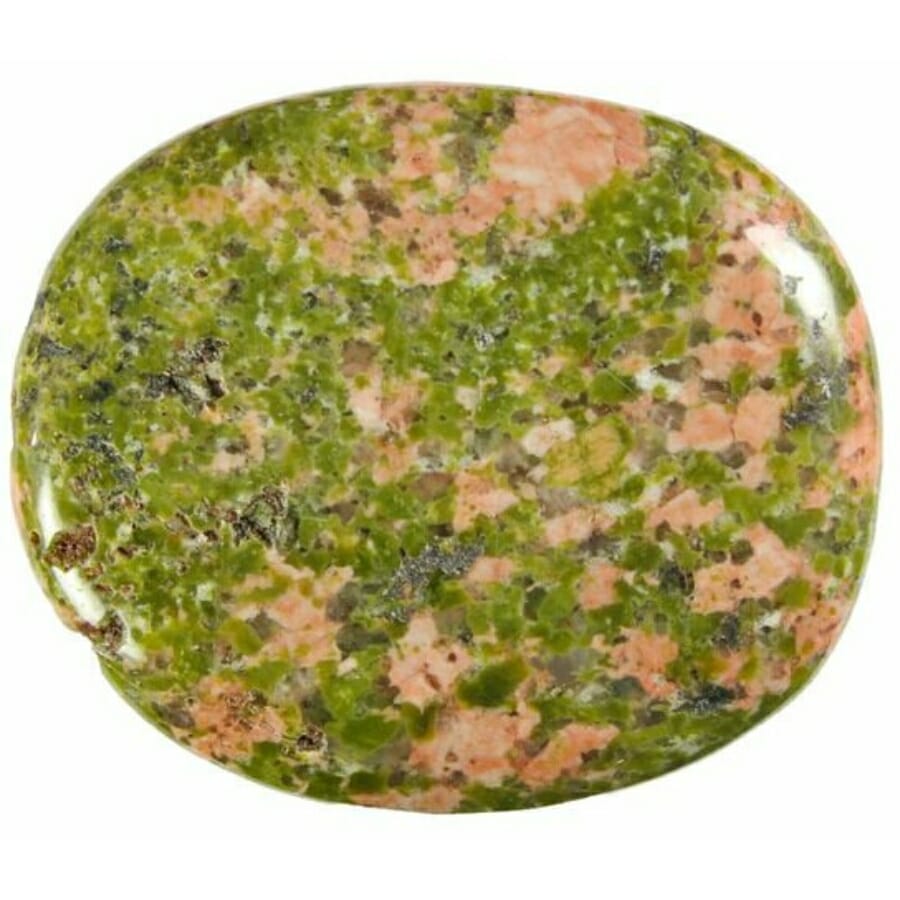
Unakite is a mineral that steals the show. Imagine a rock that has beautiful pink feldspar, clear quartz, and bright green epidote all mixed. This gorgeous mix gives the mineral its distinctive speckled green and pink look.
It forms when granite rocks change due to heat, pressure, or hot fluids. Minerals like feldspar were there before the change and mixed with the new minerals like epidote. This transformation gives birth to a unique blend of colors in it.
People value unakite for several cool reasons. For one, its bright and colorful appearance makes it super popular for making jewelry.
Beads, pendants, or even earrings made of unakite can be a statement piece! It’s also used for decorative items, like bowls or carvings, adding a natural color to any space.
All in all, unakite is a blend of beauty and mystery. Whether worn as jewelry or displayed as art, this rock never fails to capture attention!
Where you can find Unakite in North Carolina
There are several spots to find unakite in the places below:
- Area outcrops and mining dumps of Cranberry
- Birch Mine
- Marlin Knobs
- Roan Mountain area outcrops
- Roaring Fork Creek
Our Favorite Places For Gem Mining In North Carolina
We prepared a list of our favorite places for gem hunting, for both adults and kids, because we truly belive this is an activity for everybody. In these places, adults can experience real gem mining. We also made sure to cover our recommendations of the best places for kids to discover and experience searching for gems.
Always Confirm Access and Collection Rules!
Before heading out to any of the locations on our list you need to confirm access requirements and collection rules for both public and private locations directly with the location. We haven’t personally verified every location and the access requirements and collection rules often change without notice.
Many of the locations we mention will not allow collecting but are still great places for those who love to find beautiful rocks and minerals in the wild without keeping them. We also can’t guarantee you will find anything in these locations since they are constantly changing.
Always get updated information directly from the source ahead of time to ensure responsible rockhounding. If you want even more current options it’s always a good idea to contact local rock and mineral clubs and groups
Sheffield Gem Mine
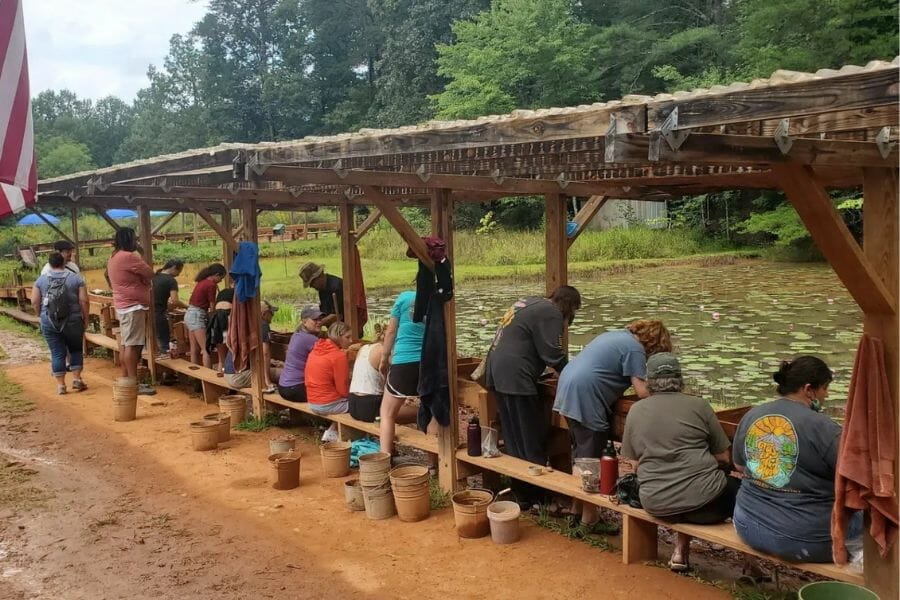
385 Sheffield Farms Rd. Franklin, NC 28734
Sheffield Gem Mine, located in Spruce Pine, has been a popular tourist destination since the 1930s. It offers visitors a chance to experience the thrill of finding their own gems right from the source. You can purchase buckets of gravel that contain a variety of gems which can be taken home to be cut and polished. Sheffield Mine also offers guided tours and educational programs that will teach you about the history of gem mining and give you geological information about different types of gemstones.
The Types of Gems Found In The Sheffield Gem Mine
This location is known for its wide range of gemstones, but it is most known for having the following for those seeking out real gem mining experience:
- Ruby
- Sapphire
The Best Time To Visit Sheffield Gem Mine
The best time to visit Sheffield Gem Mine is during the spring and early summer months, from late April to early June. While the summer months can be too hot and humid for comfortable gem mining, the weather during spring and early summer months is mild and the ground is dry, making it easier to find what you’re looking for.
If you want REAL results finding incredible rocks and minerals you need one of these 👇👇👇
Finding the coolest rocks in isn’t luck, it's knowing what to look for. Thousands of your fellow rock hunters are already carrying Rock Chasing field guides. Maybe it's time you joined the community.
Lightweight, mud-proof, and packed with clear photos, it’s become the go-to tool for anyone interested discovering what’s hidden under our red dirt and what they've already found.
Join them, and make your next rockhounding trip actually pay off.
What makes it different:
- 📍 Find and identify 140 incredible crystals, rocks, gemstones, minerals, and geodes across the USA
- 🚙 Field-tested across America's rivers, ranchlands, mountains, and roadcuts
- 📘 Heavy duty laminated pages resist dust, sweat, and water
- 🧠 Zero fluff — just clear visuals and straight-to-the-point info
- ⭐ Rated 4.8★ by real collectors who actually use it in the field
Gem Mountain Gemstone Mine
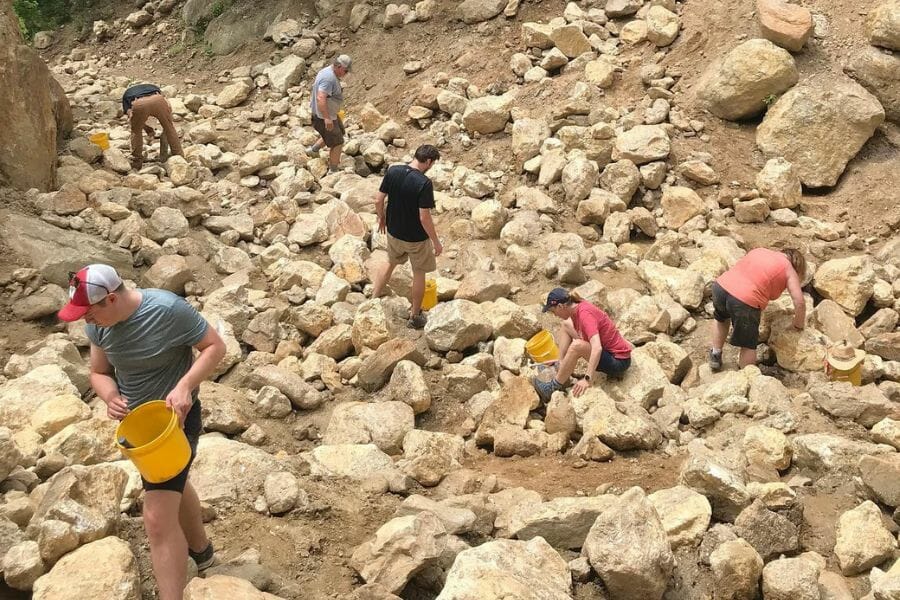
13780 Highway 226 Spruce Pine, NC 28777
Gem Mountain Gemstone Mine, a tourist attraction located in the mountains of Spruce Pine, offers the chance to dig from a real gemstone mine. It offers a variety of activities including sluicing, mining for gems, and panning for gold. You can also purchase buckets filled with dirt from various locations around the mine and then sift through it to find gemstones. The place also offers educational tours, where you can learn about geology and mining techniques.
The Types of Gems Found In The Gem Mountain Gemstone Mine
While doing mine trips in this location, these are the wide range of gemstones that you can find:
- Amethyst
- Aquamarine
- Citrine
- Emerald
- Garnet
- Moonstone
- Ruby
- Sapphire
The Best Time To Visit Gem Mountain Gemstone Mine
The best time to visit Gem Mountain Gemstone Mine is April through October. The mine is open year round, but the most productive months are April through October when the weather is mild and the water levels are low.
Thermal City Gold Mine
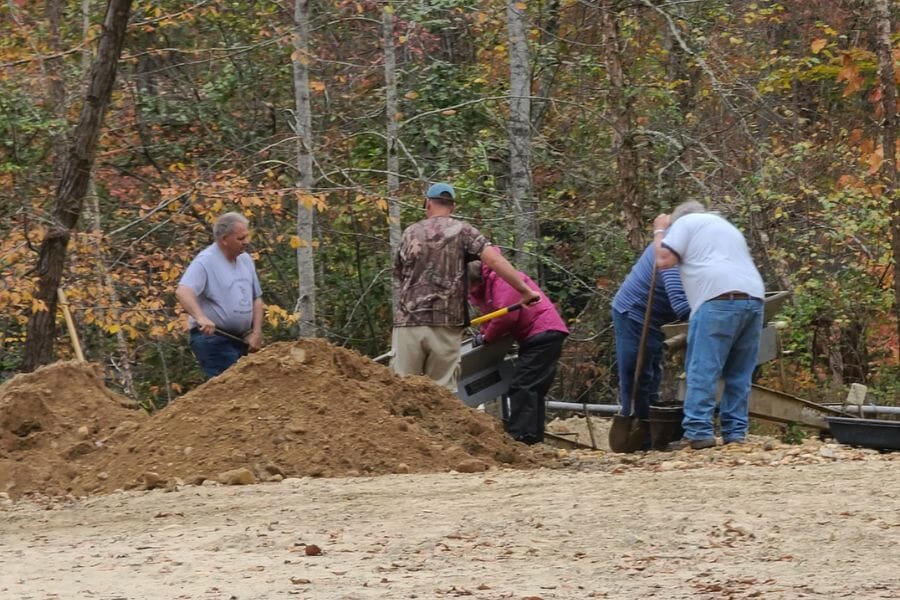
5240 US 221 North Highway, Union Mills, NC 28167
Thermal City Gold Mine, located about 50 miles west of Asheville, is the largest gold mine in the region. It has been in operation since 1933 and remains open to this day as one of the state’s premier tourist attractions for those interested in gem mining or exploring its storied past. The mine offers a variety of gem mining experiences, where you can pan for gold and gems, explore an underground mine tunnel, or take a guided tour of the property.
The Types of Gems Found In The Thermal City Gold Mine
Aside from Gold, the following gemstones, both rare and more common ones, can be found abundantly here:
- Citrine
- Emerald
- Moonstone
- Rose Quartz
- Ruby
- Smoky Quartz
- Tourmaline
The Best Time To Visit Thermal City Gold Mine
The best time to visit Thermal City Gold Mine is during the summer months of June, July and August. The weather is warmer and the days are longer, providing more opportunity for outdoor activities such as gem mining. The mine opens from April through October each year, but the summer months are ideal for gem mining due to the warmer temperatures.
Rose Creek Mine – Great for kids
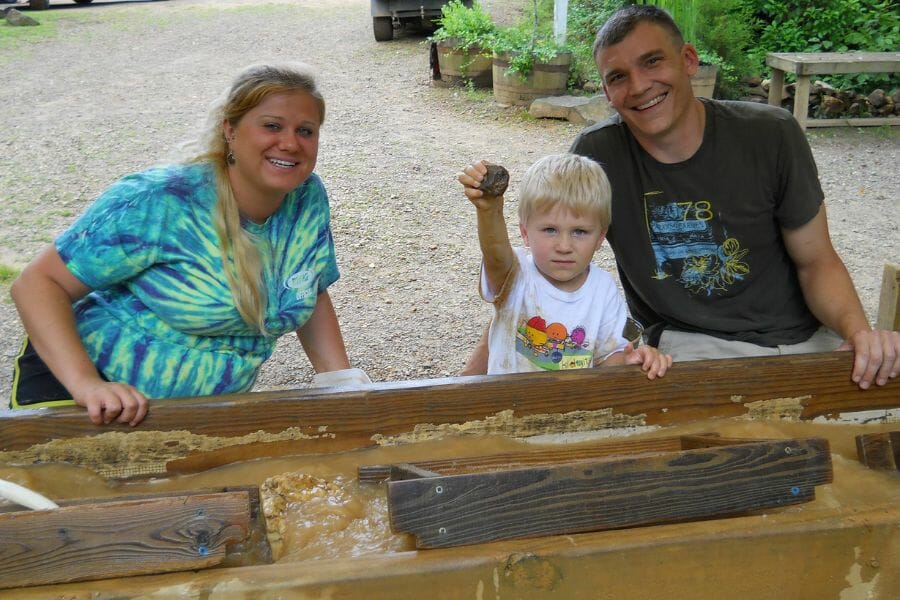
115 Terrace Ridge Drive Franklin, NC 28734
Rose Creek Mine is one of the oldest established mining operations in the state, having been in operation since 1889. You can purchase buckets of dirt that contain a variety of gems that you can search for and collect. The mine also offers classes on gem identification and cutting, as well as guided tours of the mine itself. The facility also sells jewelry made from the gems at the mine.
The Types of Gems Found In The Rose Creek Mine
This location is a great place for kids to experience searching for different varieties of gemstones. The following are some of them:
- Amethyst
- Citrine
- Garnet
- Moonstone
- Rose Quartz
- Ruby
- Sapphire
- Smoky Quartz
- Topaz
The Best Time To Visit Rose Creek Mine
The best time to visit Rose Creek Mine is during the summer months, when the weather is warm and the days are long. The mine is open from April through October, with peak season in July and August. During these months, the creek is running at its fullest and there are plenty of gems to be found.
Emerald Hollow Mine – Great for kids
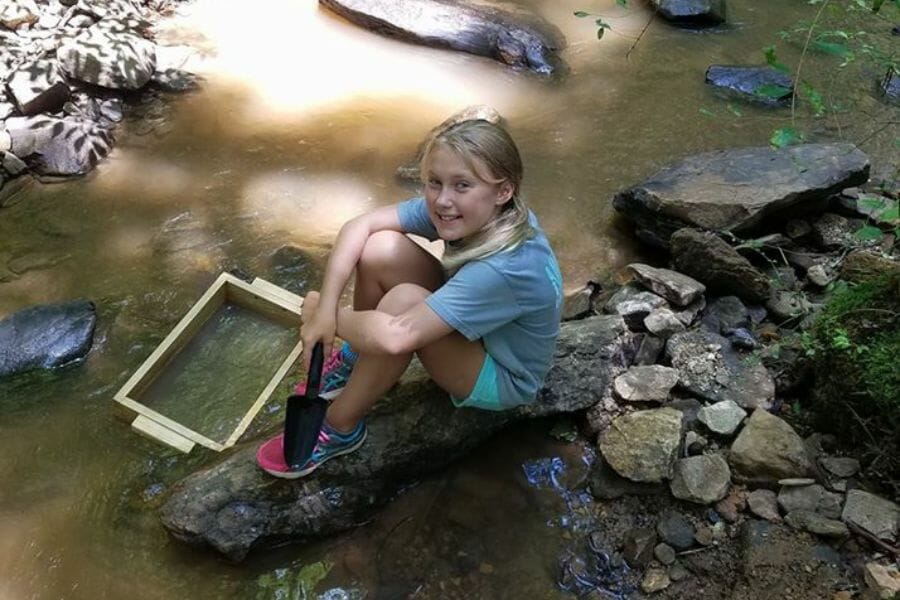
484 Emerald Hollow Mine Dr. Hiddenite, NC 28636
Emerald Hollow Mine was discovered in the late 1800s and has been a popular tourist attraction since then. It offers a hands-on experience with gem mining that is educational and fun for all ages. You can learn about gem formation and identification, screen your finds in sluice boxes, and take home any gems you find. The mine also offers special events, where you can learn more about geology and gemstones while having a great time.
The Types of Gems Found In The Emerald Hollow Mine
This place features different kinds of gems for kids to discover. The following are some of the rare and more common gems in this area:
- Amethyst
- Aquamarine
- Citrine
- Emerald
- Garnet
- Rutile
- Sapphire
- Topaz
- Tourmaline
The Best Time To Visit Emerald Hollow Mine
The best time to visit Emerald Hollow Mine is during the summer months of June, July, and August. The weather is warm and the days are long, so you can maximize your time at the mine. If you are able to visit during the week instead of on weekends, you may have a more enjoyable experience as there are fewer crowds.
Other Great Options For Real Gem Mining in North Carolina
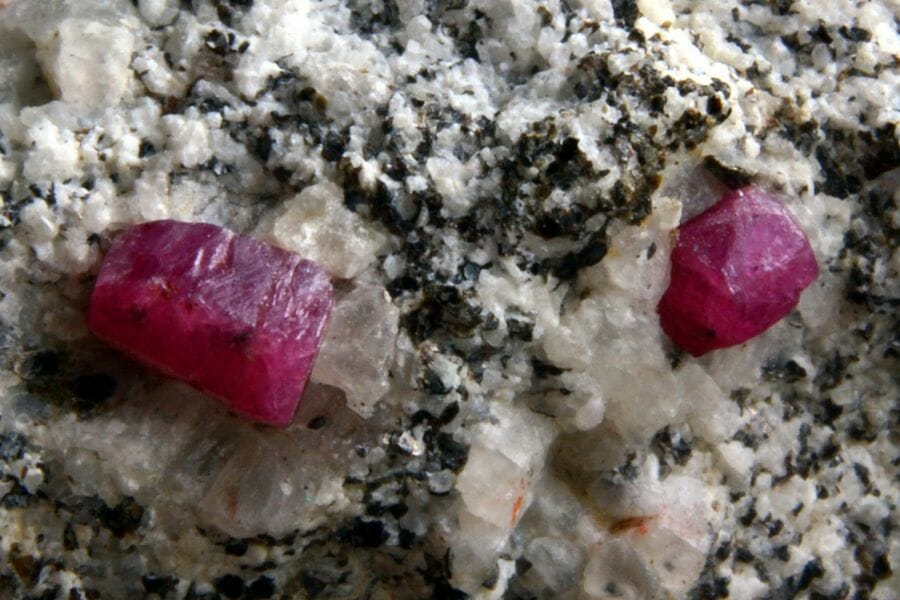
The state boasts of a vast number of different other places great for mining aside from the favorite places that we shared above. We have listed below some other great places for adults to experience real gem mining.
- Cowee Mountain Ruby Mine – Amethyst, Emerald, Garnet, Rose Quartz, Ruby, Sapphire, Smokey, Topaz
- Cherokee Ruby and Sapphire Mine – Kyanite, Moonstone, Pyrope Garnet, Rhodolite Garnet, Ruby, Rutile, Sapphire, Sillimanite
- Crowders Mountain – Kyanite, Rutile, Topaz
- Chunky Gal Mountain Mine – Corundum, Ruby
- Lost River Gold – Feldspar, Garnet, Ruby, Sapphire, Smoky-Quartz, Topaz
- Little Pine Garnet Mine – Garnet, Quartz
- Ray Mica Mine – Apatite, Beryl, Black Garnet, Fluorite, Quartz, Tourmaline
- Mason Farm Staurolite Prospect – Staurolite
- Reed Gold Mine – Azurite, Malachite, Quartz, Sphalerite, Siderite, Cuprite, Malachite, Barite
- The Reel Mine – Amethyst
- Bowling’s Mountain Mine – Pyrophyllite
- Crabtree Emerald Mine – Emerald
- Corundum Hill – Corundum, Ruby, Sapphire
- Neuse River – Amethyst
- Poplar Springs – Quartz, Rutile
- Hyatt Creek – Garnet, Staurolite
- Vengeance Creek – Calcite, Garnet, Quartz, Staurolite
- South Mountains – Aquamarine, Beryl, Feldspar, Quartz
- Pee Dee River – Chalcedony, Jasper
- Cape Fear River – Agate, Chalcedony, Jasper, Opal
The Top Public Gem Mining Locations in North Carolina
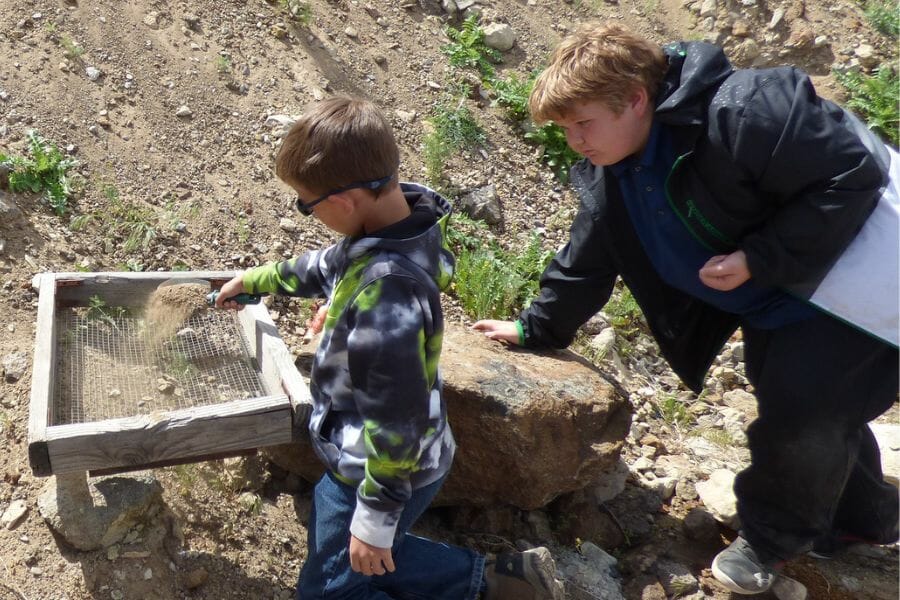
Here are also our other great recommendations for families who are looking to expose their children to the hobby of gem mining.
- Elijah Mountain Gem Mine – 2120 Brevard Road, Hendersonville, NC 28739
- Smoky Mountain Gold & Ruby Mine – Downtown Cherokee Hwy 441N Cherokee, NC, 28719
- Sandy Bottom Trail Rides – 1459 Caney Fork Road Marshall, NC 28753
- Gold City Gem Mine – 9410 Sylva Highway FranklinNC28734
- Mason Mountain Mine – 5315 Bryson City Road, Franklin, NC 28734
- Jackson Hole Gem Mine – 9770 Highlands Road, Highlands, NC 28741
- Primitive Outback Kayaking and Gem Mining – 155 Robin Lynn Lane, Otto, NC 28763
North Carolina Gem Mining Laws And Regulations
In North Carolina, recreational gem hunting is regulated by the North Carolina Department of Environmental Quality (DEQ). You must obtain a Recreational Mining Permit before you can begin collecting. The permit allows you to search for gems on public lands owned or managed by the state. It also allows you to take home up to 25 pounds of material per year. However, the permit does not allow you to use any type of mechanized equipment, such as a motorized vehicle or dredge, nor does it allow you to disturb any archaeological sites or other protected areas. It also prohibits you from entering private lands without permission from the landowner.
You should be aware that certain areas within a state park may be off limits to gem hunting. Additionally, some parks may require permits for certain activities such as panning for gold and collecting gems. Always check with park staff before beginning your gem hunting adventure.
For more information on the state’s gem mining laws and regulations, visit the North Carolina Department of Environmental Quality link above.
Additional places to mine for gems in nearby states
If you’ve already visited every spot we’ve mentioned above, see our list of suggested areas to mine gems in the nearby states below if you’re planning to travel there as well:
If you have any recommendations we haven’t covered, please leave them in the comments below!

